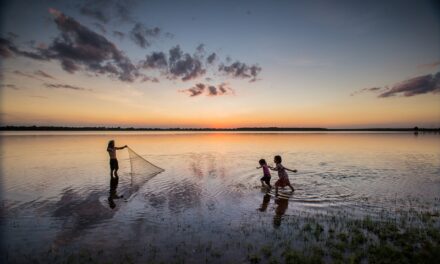Photo by Cahokia Mounds State Historic Site
5 Reasons To Visit The Astonishing Cahokia Mounds State Historic Site!
Collinsville, IL
If you’re planning a trip on the Great River Road, a tourist gem resides just outside the city of Collinsville, Illinois. Here you’ll find the remains of the most civilized prehistoric civilization north of Mexico. Dating back to 700 AD, the Cahokia Mounds Historic Site is a preservation of the archaeological remnants of the great civilization of Cahokia, home to the early Mississippians and Native Americans. Here they built over 100 astonishingly large man-made mounds for ceremonial and burial grounds, and 70 of these mounds still exist today for visitors to explore and learn about the history and culture.
Covering over 2,200 acres, a visit to Cahokia Mounds includes walking the grounds and exploring the remaining mounds, which are a sight to see in and of themselves. Visitors also can stop by the Interpretive Center to learn more about the history and the people who inhabited this great civilization.
Here are five reasons to put Cahokia Mounds on the top of the list for your next trip on the Great River Road.
Covering over 2,200 acres, a visit to Cahokia Mounds includes walking the grounds and exploring the remaining mounds, which are a sight to see in and of themselves. Visitors also can stop by the Interpretive Center to learn more about the history and the people who inhabited this great civilization.
Here are five reasons to put Cahokia Mounds on the top of the list for your next trip on the Great River Road.
Photo by Matt Gush
Of all the mounds at Cahokia, Monks Mound is the largest, towering over 100 feet, and is the centerpiece of the historic site. Built between 900 and 1200 AD, Monk Mound took 300 years to build to produce the pyramid-shaped earthen structure that covers over 14 acres. In the ancient times of the Cahokia civilization, a massive structure was built on top of the mound, which is speculated to have been the living quarters of the tribe chief and a ceremonial and government building.
Though the structure is no longer atop Monk Mound today, if you’re up for a short trek you can climb the two terraces that lead up either end of the mound. Visitors and locals alike use the area as a good place to walk and jog, so keep in mind bringing a comfortable pair of walking shoes. Once you’ve reached the top you can take in the spectacular and breathtaking views of the area, including the nearby skyline of St. Louis.
Being a World Heritage UNESCO site and a historical U.S. Landmark, the Interpretive Center at Cahokia Mounds is a world-class facility that provides an interactive look into the early Mississippian culture and its origins. The center promotes the uniqueness of this ancient world by highlighting it as an urban center for religious, political, economic, and culture.
As you step into the center, you are stepping back into the world of the Cahokia civilization. Check out the displays of Mississippian Native American culture with the life-sized dioramas of natives hunting, cooking, playing, and trading. You can also learn about the different types of ancient architecture by exploring the life-sized replica homes.
For an exciting sight head west from Monks Mound to another preserved landmark from the Cahokia civilization. Here you will find the Cahokia people’s own sun calendars, which they called Woodhenges. Much like the famous Stonehenge, these Woodhenges helped determine the changing seasons and ceremonial dates.
As you explore the Woodhenges, you can see the science and engineering that went behind building each one. While you can visit them at any time, the site occasionally holds special sunrise observances during the spring and fall equinoxes and the winter and summer solstices that you don’t want to miss.
Out of the 2,200 acres that Cahokia Mounds sits on, 800 acres are available to the public to explore and experience. If you’re feeling overwhelmed by the sheer amount of things to do at the site, there are many guided tours offered to visitors to help you have the best possible experience.
If you’d like to interact with a tour guide and other visitors, you can take the public tour of either Monks Mound or the Grand Plaza-Twin Mounds mound. During the summer months of June, July, and August, tours are conducted Wednesday through Sunday, and during April, May, September, and October these tours are only available on the weekends. If you would rather explore the site solo or with a group of friends and family, there are plenty of options for self-guided tours. These options include iPod Tours, Nature/Culture Hike Guidebook, Tape Tours, or a Tour Guidebook.
Photo by Steppinstars
Along with being home to this astounding historic and cultural landmark, the downtown of nearby Collinsville has much more to offer and could make a multi-day trip one to remember. They are home to the famous 170-foot Brooks Catsup Bottle water tower, which is a popular tourist attraction. Also, this vibrant city holds the largest Italian Festival in the Midwest each year in September, which could add a bonus event to any trip to Cahokia Mounds during the fall. You could participate in the many events and festivities celebrating the large Italian population and heritage within the area.
Another attraction is the International Horseradish Festival held annually in June. Since Collinsville produces around 85% of the world’s horseradish, this festival is a special two-day affair that you can’t experience anywhere else. Other events include the Barbeque Festival and thoroughbred horse races at Fairmount Park. To find out more about what is currently going on in Collinsville if you plan to visit, check out the events page at Rivers & Routes to explore more about hotels, restaurants, and things to do.
Content Writer and Social Media Coordinator. I paint, listen to music, and play with my dogs a lot. When I’m not doing all that, I love to read and try new things.








